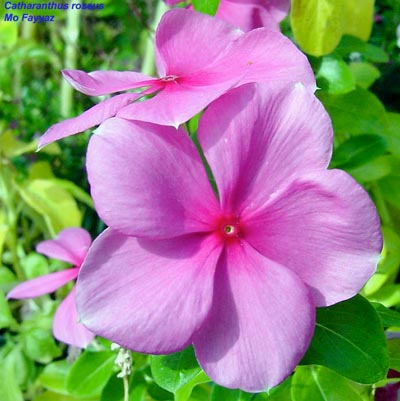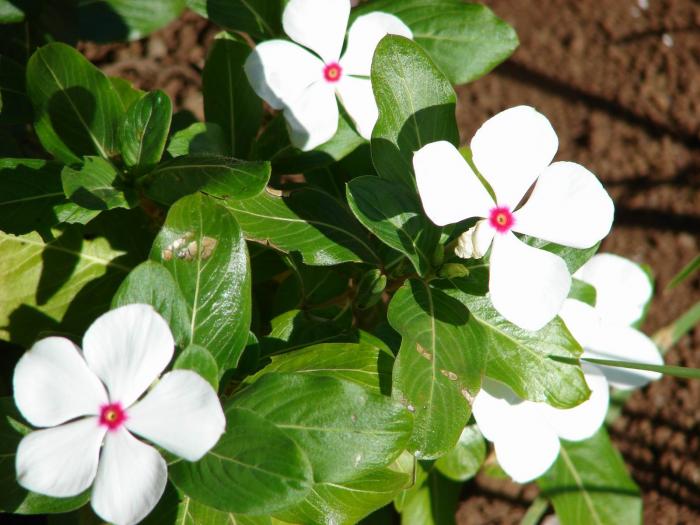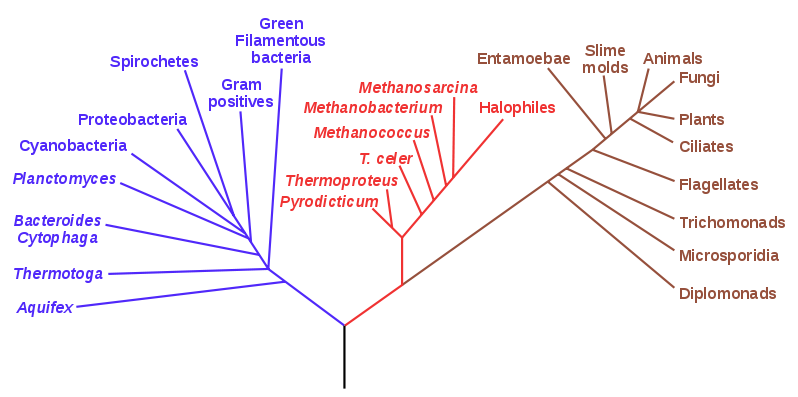The pretty pink flower that has the power to heal!

It's NOT a small world after all!
-CLASSIFICATION-
Wondering what
the scientific name Catharanthus roseus means in
English?
Well, the word Catharanthus derives from the Greek
language meaning "pure flower." While, roseus means red, rose or
rosy. Thus, resulting in how the Madagascan Periwinkle has also
been given the name the "rosy" periwinkle.
Domain:
Eukarya
Kingdom: Plantae
Phylum: Magnoliophyta
Class:
Magnoliopsida
Order:
Gentianales
Family:
Apocynaceae
Genus:
Catharanthus
Species:
Catharanthus roseus
*Photo to the right: Rosy
periwinkle. Photo courtesy of
The University of Wisconsin-Madison Botanical Garden
Domain: Eukarya All members of this domain Eukarya,
consist of organisms that have a true nucleus where the
DNA is contained, and membrane
bound organelles.
Kingdom: Plantae Catharanthus roseus belongs
to the plant kingdom because it is a photosynthetic plant which contains
chloroplasts, and is autotrophic. A distinct characteristic of the
Plantae Kingdom is that each cell is surrounded by a cell wall made of
cellulose. Due to the presence of a cell wall, plants are non-mobile.
Phylum: Magnoliophyta One of the largest and most
diverse divisions in the plant kingdom, Catharanthus roseus
belongs to the phylum Magnoliophyta because they are flowering plants.
They produce flowers, and their seeds develop within the flowers ovary.
This is the largest phylum because it represents more than 80% of all
known land plants! To see another example of a plant that falls into
this phylum check out the
shoeblack plant!
Class: Magnoliopsida This group of seed plants contain
seeds with two embryonic leaves or cotyledons. The leaves have a
net-like pattern of venation while the flowers are usually broken into
four or five parts. To see an example of a monocot, look into
Zea mays, Sweet Corn.
Order: Gentianales Plants that belong to this order
have leaves that contain two or more leaves per node.
Family: Apocynaceae This family contains mostly herbs,
along with smaller shrub type plants. Also known as the dogbane family,
these plants also contain smooth-margined leaves, and flowers are
found in clusters. Potent milky sap is another distinguishable
characteristic. Most of these plants are cultivated for their
flowers.
Genus: Catharanthus This genus contains small annual or
perennial herbs native to Madagascar, that were formerly included in the
genus Vinca.
*Photo above: Courtesy of
Forest & Kim Starr, biolib.cz
Species: Catharanthus roseus The species C. roseus had an earlier scientific name of Vinca rosea. Furthermore, C. roseus has quite a few common names some of which include: the Periwinkle, Madagascar Periwinkle, Rosy Periwinkle, Cape Periwinkle, and the Old Maid.
PHYLOGENETIC TREES
The phylogenetic tree above gathers together all of the information that you just read about. Beginning with the Domain Eukarya, and traveling all the way down to the species Catharanthus roseus, there are a a lot of stepping stones along the way, each classification containing their very own set of characteristics unique to that taxonomy.
The phylogenetic tree above does an excellent job of depicting the three different domains. The bacteria domain that you are able to see in the blue on the left, contains all single-celled organisms, also known as prokaryotes. Check out the Flesh Easting Bacteria, to get a closer look at what a bacterium can do to you! In the red you are seeing the Archaeabacteria, which surprisingly enough are more closely related to the Eukaryotes than Bacteria. The brown color contains all of the eukaryotic kingdoms, such as the plants in which the Rosy Periwinkle falls into. However, due to the vast biodiversity in which surrounds our everyday lives, not all of the kingdoms are able to fit into this tree.
Learn about the HABITAT in which the Rosy
Periwinkle resides.
Return Home


